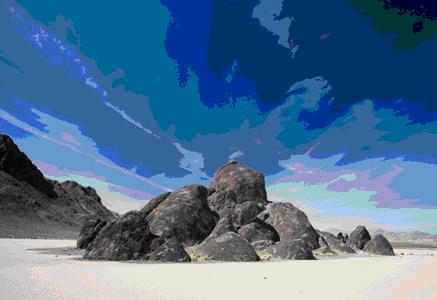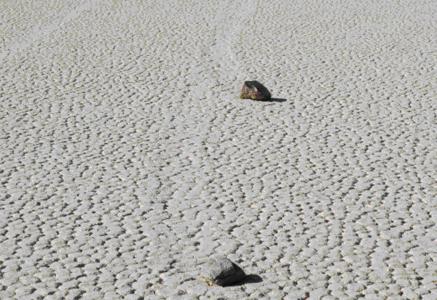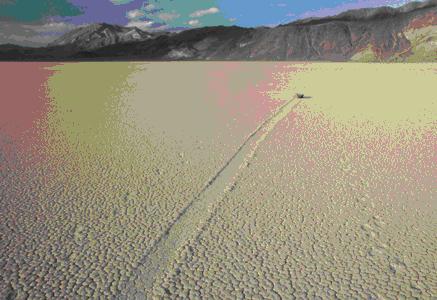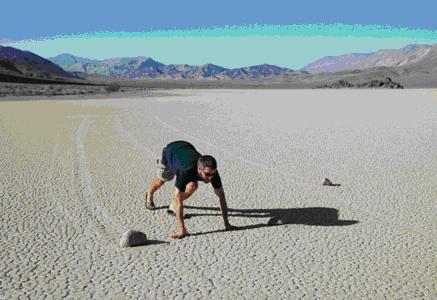The Secret of Rolling Stones (USA) EarthCache
The Secret of Rolling Stones (USA)
-
Difficulty:
-

-
Terrain:
-

Size:  (other)
(other)
Please note Use of geocaching.com services is subject to the terms and conditions
in our disclaimer.

The Secret of Rolling Stones

Road conditions:
The gravel access road to the Racetrack doesn't require a 4WD
vehicle for clearance, but the sharp rocks along the road require
that vehicles have heavy duty all-terrain tires -- usually
available only on 4WD vehicles -- to avoid the very real threat of
multiple flats.
Resource Protection:
The Racetrack Playa is a fragile area, so please do not walk on the
Racetrack when it is wet to avoid leaving deep, muddy footprints.
Do not pick up, move, or remove any of the rocks on the
Racetrack.
Safety:
Visiting the Racetrack during the heat of summer from mid-May
through late September is not recommended unless one is fully
prepared with two gallons of water per person and extra food.


Never before could any human being watch these stones move!
Rocks in Californian Death Valley seem to change positions over
night! Latest research results explain what makes these rocks
move…
Death Valley is a national park and is also home of a mysterious
phenomenon: Rocks at Racetrack Playa are self-moving! Some
of them appear to move up to 4.5 miles per hour – faster than
normal pedestrians (No proven fact! No one knows how fast the rocks
move, but it has been speculated that they may move as fast as 4 or
5 miles per hour!). Some rocks weigh 350 kilograms and leave
visible stress marks in the desert sand. For years scientists have
been puzzling about what causes the migration and why the rocks
move in different directions: upward, downward, zigzag and in
pairs. What is also curious: in front of some marks you do not find
a rock at all. Maybe wind? Magnetism? Smooth sheets of ice in
winter? A recent expedition of NASA scientists could have solved
this mystery.

Phone home?
Sometimes we use supernatural or alien theories to explain
phenomena we don't understand. In the 1960s, UFO fans suggested
that aliens move these rocks to communicate. A moot question. Did
E.T. arrive home?
Mischief… from an academic point of view. Many theories draw
on weather and wind which that make stones roll. But you will need
wind speeds of 500 mph to move these heavy stones. Hurricane
Katrina only reached 190 mph! “Wind” does not seem to
be the right idea.
To catch rocks in the act of moving, scientists have suggested
setting up cameras for observation. Durable installations are
prohibited because Death Valley is a listed area, and 91 percent of
it is still intact wilderness. Furthermore, it is not allowed to
enter when it rains because footprints could cause everlasting
changes of the area's surface.

Girl Talk
Since 1948, scientists have been investigating these rambling
rocks. They got to be friends and named them after women. For one,
the biggest chunk which moves 18 meters in one month is called
Karen. Diane is fastest and moves 880 meters a month.
One of the first scientists who camped out at this high plateau was
Thomas Clement, a geologist. In 1952, he tried to solve this
mystery, but he could not leave his tent because of heavy storms
and rainfalls. The nNext morning he found fresh sand marks, and
something important attracted his interestattention: The rainstorm
left a slippery water film at this section. Could this be a kind of
lubricating film for rocks? But Clement could not explain why rocks
moved in different directions, leaving zigzags and even circular
marks.
 Geologist Bob Sharp accomplished some analyses at Racetrack Playa
between 1968 and 1974. During this time he had been following 30
different rocks. He did not catch the rocks while moving, but he
noticed changes in their positions. His conclusion: Certain weather
conditions (slick floor and stormy nights, for example) bring cause
stones to move up to one meter per second! His report contained
another curious hint: “I can’t explain it myself, but
seven rocks completely disappeared!”
Geologist Bob Sharp accomplished some analyses at Racetrack Playa
between 1968 and 1974. During this time he had been following 30
different rocks. He did not catch the rocks while moving, but he
noticed changes in their positions. His conclusion: Certain weather
conditions (slick floor and stormy nights, for example) bring cause
stones to move up to one meter per second! His report contained
another curious hint: “I can’t explain it myself, but
seven rocks completely disappeared!”
Also, Paula Messina, a geologist from San Jose State University,
analyzed the sliding rocks. For five years she had been mapping all
162 stones using a GPS device. She found that neither size or
weight nor the form of the rocks could predict how far or which
direction rocks move. She guesses that water flowing down from the
mountains water (particularly after heavy rainfall) carries
particles of clay to the Racetrack and makes it greasy. In
addition, heavy winds (up to 60 mph) could make the rocks move. In
her dissertation she writes: “A fascinating conclusion: There
is no conclusion!”

Will Sensors shed Light on it?
Recently, 17 scientists and students under the special direction of
NASA scientists examined the Racetrack phenomenon. They got special
permission to spend the night in Death Valley. They analyzed GPS
data and so-called Hygrochrones which measure wetness and
temperature. NASA scientist Gunther Kletetschka burrowed these
sensors into the ground months before starting this expedition.
Examinations showed a layer of ice in March which put stones in
position to glide. This "ice thesis" also explains why big and
heavy rocks move more than smaller ones: Once on the move they do
not brake as fast as small rocks do.
Above all, the "ice thesis" illuminates the mysterious
disappearances of rocks: When ice is melting, rocks settle down in
sand. The scientists determined that not only ice is responsible
for the “rolling stones,” but also alga, clay, wind,
and rain. How factors work together is still a mystery. Paula
Messina does not believe in this theory because they did not find
any traces of ice. Analyses in laboratories should bring some
clarification now. Scientists have received permission to examine
the sand of Racetrack Playa at university labs. To be
continued…
To claim this earthcache, send a picture of yourself and/or your
group at Death Valley's Racetrack and tell the cache owner how many
rocks you found and what you think is reason for the “rolling
stones” phenomenon.
Additional Hints
(No hints available.)